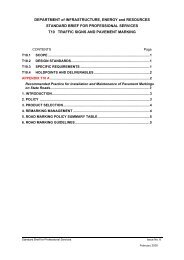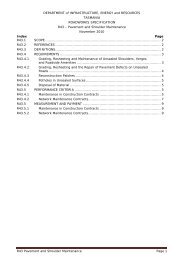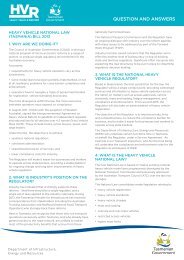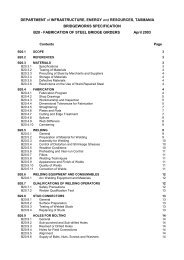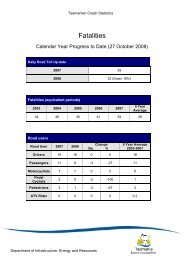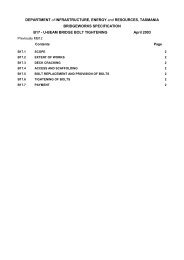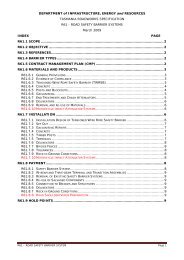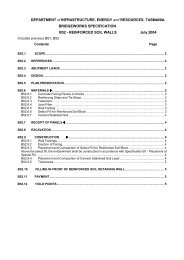Public Environment Report Tarkine Forest Drive ... - Transport
Public Environment Report Tarkine Forest Drive ... - Transport
Public Environment Report Tarkine Forest Drive ... - Transport
- No tags were found...
You also want an ePaper? Increase the reach of your titles
YUMPU automatically turns print PDFs into web optimized ePapers that Google loves.
All potential habitats were inspected for several threatened orchid species that havebeen previously recorded from the vicinity. The timing was chosen to maximiseopportunity for identifying the species to coincide with their flowering period.Locations of previous records of threatened orchids were targeted (NBES 2011). Allthreatened species identified were documented. Detailed information on numbers ofplants and the distribution in relation to the existing road were measured andrecorded. At one location known as Tiger Flats (northern end of Segment B – Figure4.1), intensive searching was undertaken in the area immediately surrounding anyobserved plants to ensure all plants present were recorded. This involved passes onfoot at 2 m intervals by three ecologists. This area was subsequently reinspected bymembers of Threatened Plants Tasmania in 2010 (Threatened Species Section 2010).4.9.3 Fauna assessmentFauna habitats were reviewed and assessed for their potential to provide habitats forthreatened fauna identified from the desktop study as occurring or potentiallyoccurring within the study area. The mapped vegetation communities were used as abasis for identifying fauna habitats (NBES 2011).Fauna observations were recorded on all road sections, although sections that werewalked enabled considerably more observations of scats and footprints of theTasmanian devil and spotted-tailed quoll to be recorded. Opportunistic observations ofmammal fauna throughout the survey were recorded, including roadkill (NBES 2011).A subsequent survey of the entire route was undertaken over 2 days in March 2012.Attention was given to identifying location of carnivore scats as a means of identifyingpotential roadkill hot spots for vertebrate carnivore such as Tasmanian devil andspotted-tailed quoll. Inspections were also made of all creek crossings withconsideration of suitability for passage by giant freshwater crayfish. The purpose ofthis investigation was to identify potential locations where animals may be forced toleave the creek to cross the road.The potential for the project to introduce or expand the range of feral animals andanimal diseases (notably Chytrid fungus) was also considered (NBES 2011).Vertebrate carnivoresThe northwest of Tasmania is an important area for two threatened species ofvertebrate carnivore, the Tasmanian devil and the spotted-tailed quoll (Jones and Rose1996 cited in NBES 2011). Therefore, the fauna survey has focused on these species.The Tasmanian devil has been subject to intensive study and research in recent yearsbecause of the threat posed by DFTD to the long-term survival of the largest marsupialcarnivore in Australia (NBES 2011).The potential impact of the proposed <strong>Tarkine</strong> <strong>Forest</strong> <strong>Drive</strong> has been the subject ofsignificant media interest, provoked by an open letter sent by a group of concernedscientists to Peter Garrett, the then Minister of DEWHA and to Mr David Llewellyn theformer Minister of DPIPWE. The concerns that have been expressed are based on thenotion that the area provides an important refuge for the Tasmanian devil. The area isunderstood to support relatively high densities of devils that are not yet infected byDFTD (Hawkins et al. 2006, MacCallum et al. 2007 cited in NBES 2011).There is a view that the development of the <strong>Tarkine</strong> <strong>Forest</strong> <strong>Drive</strong> will allow themovement of DFTD into an uninfected area as well as resulting in a significant increasein roadkill which would provide additional pressure on an already threatened species.An aim of the fauna survey was to examine and test these assumptions or providerecommendations as to how they could be further tested (NBES 2011).The fauna assessment sought to collate the most recent information and knowledge ofthe Tasmanian devil and DFTD. It considers the dispersal patterns of the Tasmaniandevil and the impact roads might have on the species.Ref: HB09080H001 PER <strong>Tarkine</strong> <strong>Drive</strong> 33P Rev 00/DL/CL/jw 39



